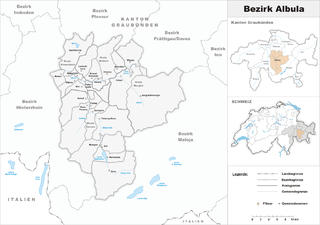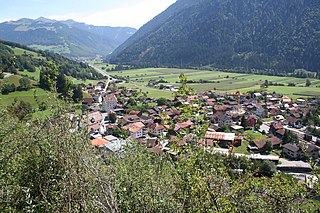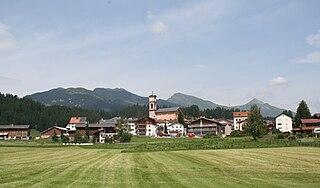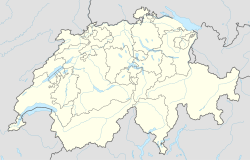
Vals is a village and a municipality in the Surselva Region in the canton of Graubünden in Switzerland. On 1 January 2015 the former municipality of St. Martin merged into the municipality of Vals.

Albula District was one of the eleven administrative districts in the canton of Graubünden in Switzerland. It had an area of 723.13 km² and had a population of 8,210 in 2015. It was replaced with the Albula Region on 1 January 2017 as part of a reorganization of the Canton.

Bever is a municipality in the Maloja Region in the Swiss canton of Graubünden.

Trun is a municipality in the Surselva Region in the canton of Graubünden in Switzerland. The municipality of Schlans merged on 1 January 2012 into the municipality of Trun.

Avers is a high Alpine valley region and a municipality in the Viamala Region in the Swiss canton of Graubünden. It includes Juf, the highest-altitude year-round settlement in Europe.

Bergün/Bravuogn is a village and former municipality in the Albula Region in the canton of Graubünden in Switzerland. The double name (German/Romansh) has been the official name since 1943. On 1 January 2018 the former municipalities of Bergün/Bravuogn and Filisur merged into the new municipality of Bergün Filisur.

Andeer is a municipality in the Viamala Region in the Swiss canton of Graubünden. In 2009 Clugin and Pignia merged into Andeer.

Andiast is a former municipality in the Surselva Region in the Swiss canton of Graubünden. Until 1943, it was known as Andest.

Grüsch is a Swiss village in the Prättigau and a municipality in the political district Prättigau/Davos Region in the canton of Graubünden. On 1 January 2011, the former municipalities of Fanas and Valzeina were merged with Grüsch.

Küblis or Kublis is a Swiss village in the Prättigau and a municipality in the political district Prättigau/Davos Region in the canton of Graubünden.

Lantsch/Lenz is a municipality in the Albula Region in the canton of Graubünden in Switzerland.

Schmitten is a municipality in the Albula Region in the canton of Graubünden in Switzerland.

Hinterrhein is a village and a former municipality in the Viamala Region in the Swiss canton of Graubünden. The village is located near the start of the river Hinterrhein/Rein Posteriur, one of the two initial tributaries of the Rhine. On 1 January 2019 the former municipalities of Hinterrhein, Nufenen and Splügen merged to form the new municipality of Rheinwald.

Tiefencastel is a village and a former municipality in the district of Albula in the canton of Graubünden in Switzerland. On 1 January 2015 the former municipalities of Alvaschein, Mon, Stierva, Tiefencastel, Alvaneu, Brienz/Brinzauls and Surava merged to form the new municipality of Albula/Alvra.

Thusis is a municipality in the Viamala Region in the Swiss canton of Graubünden. On 1 January 2018 the former municipality of Mutten merged into the municipality of Thusis.

Rothenbrunnen is a municipality in the Viamala Region in the Swiss canton of Graubünden.

Sagogn is a municipality in the Surselva Region in the canton of Graubünden in Switzerland.

Albula/Alvra is a municipality in the Albula Region in the canton of Graubünden in Switzerland. On 1 January 2015, the former municipalities of Alvaschein, Mon, Stierva, Tiefencastel, Alvaneu, Brienz/Brinzauls, and Surava merged to form the new municipality of Albula/Alvra.
Albula Region is one of the eleven administrative districts in the canton of Graubünden in Switzerland. It has an area of 683.51 square kilometers (263.90 sq mi) and a population of 8,175 .. It was created on 1 January 2017 as part of a reorganization of the Canton.

Bergün Filisur is a municipality in the Albula Region in the canton of Graubünden in Switzerland. On 1 January 2018 the former municipalities of Bergün/Bravuogn and Filisur merged to form the new municipality of Bergün Filisur.




























